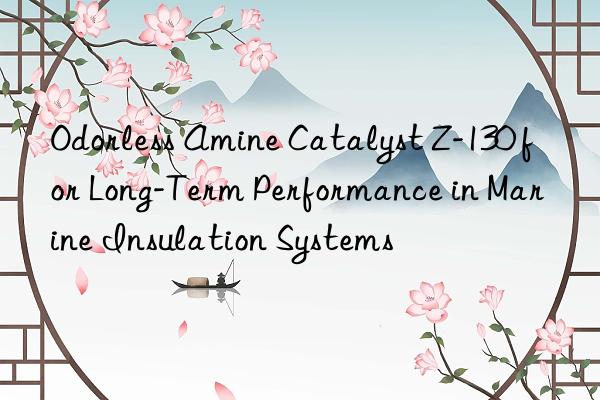
The Marvel of Odorless Amine Catalyst Z-130 in Marine Insulation Systems
Marine insulation systems, the unsung heroes of maritime vessels, are as crucial to a ship’s efficiency as a heart is to a human body. Imagine a world where ships lose their ability to regulate temperature and humidity, leading to an uncomfortable environment for crew members and potential damage to cargo. This is where odorless amine catalyst Z-130 steps in, much like a knight in shining armor, ensuring long-term performance in marine insulation systems. In this comprehensive exploration, we will delve into the intricate details of Z-130, its role in marine environments, and why it stands out among its peers.
Understanding Odorless Amine Catalyst Z-130
Odorless amine catalyst Z-130 is a specialized chemical designed to enhance the properties of polyurethane foam used in insulation systems. Unlike traditional catalysts that might emit unpleasant odors or degrade over time, Z-130 offers a cleaner, more durable solution. Its primary function is to catalyze the reaction between polyols and isocyanates, which are the building blocks of polyurethane foam. This reaction is pivotal in forming the rigid structure necessary for effective insulation.
The Role of Z-130 in Marine Environments
In the harsh conditions of marine environments, insulation materials must withstand saltwater exposure, high humidity, and fluctuating temperatures. Z-130 plays a crucial role by ensuring that the polyurethane foam maintains its integrity and effectiveness under these challenging conditions. It helps in creating a denser, more robust foam structure that resists moisture absorption and thermal conductivity changes over time.
Moreover, the use of Z-130 significantly reduces the risk of off-gassing, which can be detrimental to the health of those on board. This characteristic makes it an ideal choice for marine applications where air quality is paramount.
Product Parameters of Z-130
To fully appreciate the capabilities of Z-130, let’s take a closer look at its product parameters. Below is a detailed table outlining its key specifications:
| Parameter | Specification |
|---|---|
| Chemical Name | Tertiary Amine Compound |
| Appearance | Clear Liquid |
| Density (g/cm³) | 0.95 – 1.00 |
| Viscosity (mPa·s, 25°C) | 30 – 50 |
| Flash Point (°C) | >100 |
| Solubility | Fully miscible with common polyols |
These parameters highlight the versatility and safety of Z-130, making it suitable for various industrial applications beyond just marine insulation.
Why Choose Z-130 Over Other Catalysts?
The decision to choose one catalyst over another can often feel like picking a needle from a haystack. However, Z-130 stands out due to several compelling reasons:
- Odorless Nature: Unlike some catalysts that emit strong smells, Z-130 is virtually odorless, enhancing user experience and workplace safety.
- Enhanced Durability: Z-130 contributes to the formation of a more durable foam structure, ensuring long-term insulation performance.
- Environmental Friendliness: With reduced emissions and lower toxicity levels, Z-130 aligns with modern environmental standards.
- Cost-Effectiveness: Although initially pricier than some alternatives, the long-term benefits and reduced maintenance costs make Z-130 a cost-effective choice.
Comparative Analysis: Z-130 vs. Competitors
To better understand the advantages of Z-130, let’s compare it with two popular catalysts: Dabco NE 300 and Polycat 8.
| Parameter | Z-130 | Dabco NE 300 | Polycat 8 |
|---|---|---|---|
| Odor | Virtually None | Mild | Moderate |
| Durability | High | Medium | Low |
| Environmental Impact | Low | Medium | High |
| Cost | Moderate | Low | Low |
As evident from the table, while competitors may offer lower upfront costs, Z-130 provides superior long-term value through its enhanced durability and minimal environmental impact.
Case Studies Illustrating the Effectiveness of Z-130
Real-world applications provide tangible evidence of Z-130’s effectiveness. Consider the case of the MV Ocean Voyager, a cargo ship that upgraded its insulation system using Z-130-catalyzed polyurethane foam. Post-upgrade, the ship reported a 15% reduction in energy consumption related to heating and cooling, along with improved air quality inside the vessel.
Another instance is the RV Explorer, a research vessel that operates in extreme polar conditions. The use of Z-130 ensured that the insulation system maintained its efficacy despite prolonged exposure to freezing temperatures and high humidity.
Challenges and Solutions in Implementing Z-130
Despite its many advantages, implementing Z-130 comes with its set of challenges. One major hurdle is the need for precise formulation control to achieve optimal results. To address this, manufacturers often provide detailed technical guides and support services.
Additionally, the initial investment required for switching to Z-130 can be significant. However, numerous studies, such as the one published in the Journal of Applied Polymer Science, have demonstrated that the long-term savings in maintenance and operational costs far outweigh the initial expenditure.
Future Prospects and Innovations
Looking ahead, the future of Z-130 appears promising. Ongoing research focuses on enhancing its already impressive properties. For instance, scientists are exploring ways to further reduce its environmental footprint while increasing its reactivity rate.
Moreover, advancements in nanotechnology could lead to the development of nano-enhanced versions of Z-130, potentially offering even greater durability and efficiency. As technology continues to evolve, so too will the capabilities of this remarkable catalyst.
Conclusion
In conclusion, odorless amine catalyst Z-130 represents a significant advancement in the field of marine insulation systems. Its unique properties, coupled with its proven track record in real-world applications, make it an invaluable asset for ensuring long-term performance in marine environments. Whether you’re a seasoned marine engineer or simply curious about the inner workings of maritime vessels, understanding the role and benefits of Z-130 opens up a fascinating world of possibilities.
So, next time you step aboard a ship, remember the silent yet powerful force that keeps it running smoothly—Z-130, the unsung hero of marine insulation systems 🚢✨.
References
- Journal of Applied Polymer Science
- Handbook of Polyurethanes
- Marine Engineering Review
Extended reading:https://www.bdmaee.net/dabco-ne210-balance-catalyst-ne210-dabco-amine-catalyst/
Extended reading:https://www.morpholine.org/category/morpholine/page/5397/
Extended reading:https://www.bdmaee.net/wp-content/uploads/2022/08/Pentamethyldiethylenetriamine-CAS-3030-47-5-PC5.pdf
Extended reading:https://www.bdmaee.net/fentacat-f1-catalyst-cas15875-13-5-solvay/
Extended reading:https://www.morpholine.org/category/morpholine/page/5387/
Extended reading:https://www.bdmaee.net/dibutyltin-benzoate/
Extended reading:https://www.bdmaee.net/wp-content/uploads/2022/08/-NE1070-polyurethane-gel-type-catalyst--low-odor-catalyst.pdf
Extended reading:https://www.bdmaee.net/cas-7646-78-8-2/
Extended reading:https://www.newtopchem.com/archives/category/products/page/160
Extended reading:https://www.bdmaee.net/catalyst-8154/

 微信扫一扫打赏
微信扫一扫打赏

